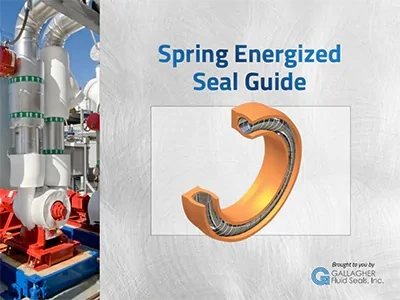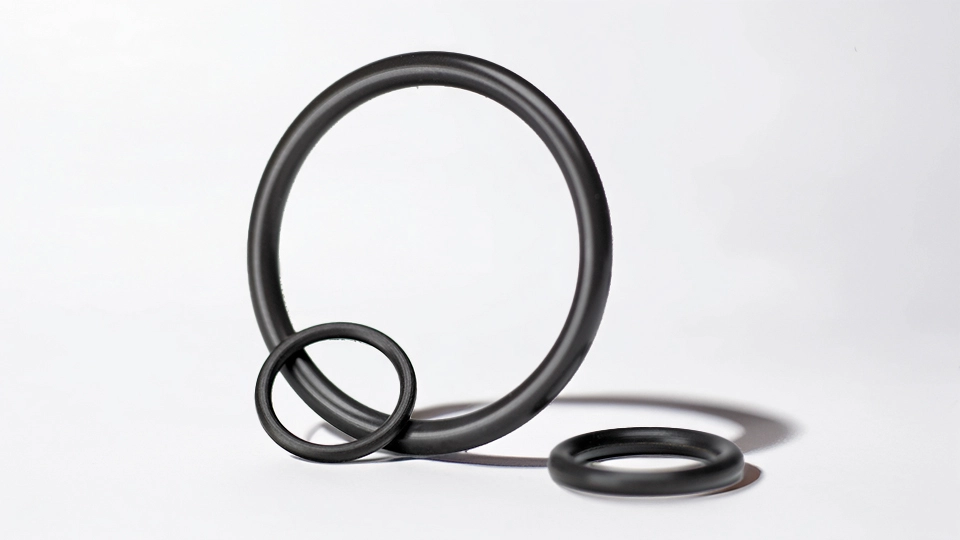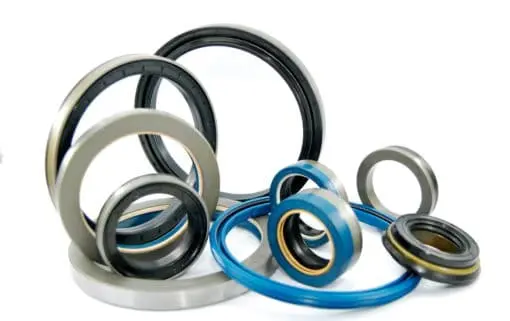This article was written by Nathan Tangyunyong, applications engineer, at Parker O-Ring & Engineered Seals Division
Gallagher Fluid Seals is a premier Parker distributor and Seal Technology Center for Parker Hannifin.
A common question that comes from many customers is: “Can you tell me which O-ring compound meets this ASTM D2000 callout?” It’s understandable, since at first glance, the ASTM D2000 callout can be intimidating for determining the type of O-ring material. However, the ASTM D2000 is a very useful tool to quickly specify requirements for O-ring materials, and is standardized so it is easy to interpret industry wide. So, what is the ASTM D2000 specification, and how can I interpret it?
What is ASTM D2000?
ASTM D2000 is a standardized description of rubber compounds. It was first developed for use in the automotive industry, however it is now used by many industries to specify requirements for rubber compounds in a consistent way. Think of the specification as a common language everyone in the rubber industry speaks, allowing us to communicate easily with each other without an interpreter. An ASTM D2000 callout will look like the following example, and we will break down piece by piece what each part in the callout indicates.
Breaking Down an ASTM D2000 Callout
M4HK710 A1-11 B38 EF31 EO78 Z1
The “M” and “10” of this ASTM callout specify the tensile strength requirement of the rubber. An “M” at the start of the ASTM D2000 callout indicates the tensile strength requirement of the rubber must be in metric units. The metric units for tensile strength is MPa. If no “M” is present, then the tensile strength requirement is in English units, psi. In our example, the ASTM D2000 callout is requiring a compound with a tensile strength in metric units, in this case 10 MPa. Here are a few other examples.
4HK710
No “M” is present, this indicates the tensile strength requirement must be in English units, in this case 1000 psi.
M4HK708
The ASTM callout indicates metric units for the tensile strength requirement, 8 MPa.
4HK708
The ASTM callout indicates English units for the tensile strength requirement, 800 psi.
M4HK710 A1-11 B38 EF31 EO78 Z1
The “4” in the ASTM D2000 indicates the grade number of the testing. Grade numbers indicate the level of testing required for the rubber to meet. In our example, the rubber is expected to meet Grade 4 testing requirements. There can be up to 8 or 9 grades with different specification limits depending on the type of rubber. Each testing grade number has slightly different requirements the rubber must meet, some more stringent than others. An example of the grade numbers for A19 Heat Aging requirements for each grade is shown below.
M4HK710 A1-11 B38 EF31 EO78 Z1
The “HK” in this ASTM callout indicates the type and class of the polymer. The type is called out by the first letter, “H” in our example, and the class is determined by the second letter “K”. The type of the rubber is based on changes during testing at a specified temperature of tensile strength no more than +/- 30%, elongation change no more than -50%, and a change of hardness no more than +/- 15 points after heating aging for 70 hours. The temperature for testing the type of rubber is shown in the table below.
Table 1: Basic Requirements for Establishing Type by Temperature
| Type | Test Temperature, °C |
| A | 70 |
| B | 100 |
| C | 125 |
| D | 150 |
| E | 175 |
| F | 200 |
| G | 225 |
| H | 250 |
| J | 275 |
| K | 300 |
The class is based on the resistance of the material to swelling in IRM 903 oil after immersion for 70 hours, at a temperature called out by the type. Limits for swelling for each class is shown in the table below.
Table 2: Basic Requirements for Establishing Class by Volume Swell
Class | Volume Swell, max, % |
A | no requirement |
B | 140 |
C | 120 |
D | 100 |
E | 80 |
F | 60 |
G | 40 |
H | 30 |
J | 20 |
K | 10 |
These letter combinations can often indicate the material polymer. ASTM D2000 breaks down the different rubber types using the following material codes.
Table 3: Polymers Most Often Ued in Meeting Material Requirements
Classification System D200-SAE J200 Material Designation (Type and Class) | Type of Polymer Most Often Used |
AA | Natural rubber, relcaimed rubber, SBR, buty, EP, polybutadiene, polyisoprene |
AK | Polysulfides |
BA | Ethylene propylene, high temperature SBR and butyl compounds |
BC | Chloroprene polymers (neoprene), cm |
BE | Chloroprene polymers (neoprene), cm |
BF | NBR polymers |
BG | NBR polymers, urethanes |
BK | NBR |
CA | Ethylene Propylene |
CE | Chlorosulfonated polyethylene (Hypalon), cm |
CH | NBR polymers, epichlorohydrin polymers |
DA | Ethylene propylene polymers |
DE | CM, CSM |
DF | Polyacrylic (butyl-acrylate type) |
DH | Polyacrylic polymers, HNBR |
EE | AEM |
EH | ACM |
EK | FZ |
FC | Silicones (high strength) |
FE | Silicones |
FK | Fluorinated silicones |
GE | Silicones |
HK | Fluorinated elastomers (Viton, Fluorel, etc.) |
KK | Perfluoroelastomers |
In our example, the "HK" indicates a fluorocarbon would likely meet the requirements for the seal.
M4HK710 A1-11 B38 EF31 EO78 Z1
The “7” portion of the ASTM callout describes the shore A hardness of rubber. In our example, the hardness called out for the rubber is 70 durometer, ± 5.
M4HK710 A1-11 B38 EF31 EO78 Z1
The last part of the ASTM callout describes testing that is required for the materials to meet. The testing types can be broken down into two parts. The letter portion of the suffix for the testing describes the type of tests required for the compound. A list of the testing types is shown below.
Suffix Letter | Test Required |
A | Heat Resistance |
B | Compression Set |
C | Ozone or Weather Resistance |
D | Compression-Deflection Resistance |
EA | Fluid Resistance (Aqueous) |
EF | Fluid Resistance (Fuels) |
EO | Fluid Resistance (Oils and Lubricants) |
F | Low Temperature Resistance |
G | Tear Resistance |
H | Flex Resistance |
J | Abrasion Resistance |
K | Adhesion |
M | Flammability Resistance |
N | Impact Resistance |
P | Staining Resistance |
R | Resilience |
SR | Compressive Stress Relaxation |
Z | Any special requirement, which shall be specified in detail |
The second portion of the suffix, the numbers, indicate the temperature and duration at which the tests must be conducted. Take for example the difference between B37 and B38 testing.
| B37 | Compression set, Test Methods D395, Method B, max, %, 22 hrs at 175°C |
| B38 | Compression set, Test Methods D395, Method B, max, %, 22 hrs at 200°C |
Both are 22 hour compression set tests . However, B37 is set at 175°C, while B38 is set at 200°C. So, tests with the same letter portion as part of the suffix will be the same type of test, but if they have different numbers in the second part of the callout, they will have different temperatures or durations for the testing.
So, for our example, our compound will have the following compound test requirements:
- A1-11 = Heat resistance test for 70 hours at 275°C
- B38 = Compression set testing for 22 hours at 200°C
- EF31 = Fuel C fluid testing for 70 hours at 23°C
- E078 = Service fluid No.101 fluid testing for 70 hours at 200°C
- Z1 = Could be any special requirement not covered in ASTM D2000, such as the color of the rubber or fluid tests not standard to ASTM D2000. A common Z callout is to change the durometer from 70 or 80 Type A to 75 ± 5
To summarize, the ASTM callout used as our example will call out for the following type of rubber.
M4HK710 A1-11 B38 EF31 EO78 Z1
This ASTM callout requires a 70 durometer fluorocarbon rubber, with a minimum required tensile strength of 10 MPa. It also requires Grade 4 heat age, compression set, fuel C fluid, and service fluid No 101 testing, with an additional special requirement not covered in ASTM D2000.
Other requirements can be compiled into an ASTM D2000 callout following this standard formula, which can then be easily interpreted by someone familiar with the standard.
For more information about ASTM D2000, or any Parker seals, contact Gallagher Fluid Seals today.






